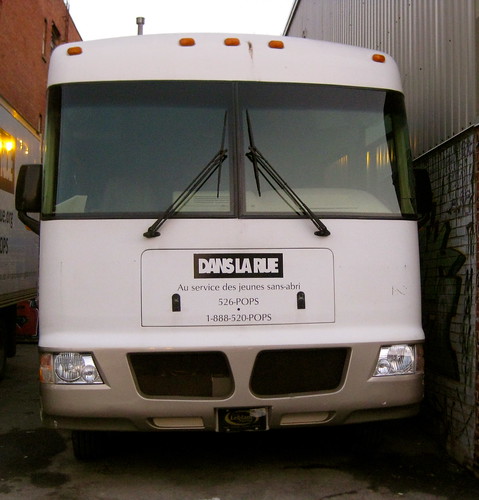
For three years I volunteered with Dans la Rue van, handing out hot dogs to Montreal’s homeless on Monday evenings. The first thing volunteers learn is that hot dogs are just a hook: their nutritious value may be disputable, but they reliably draw street kids into the van where they can socialize in safety, pick up emergency supplies like blankets, socks and condoms, and be put in touch with resources including shelters, clinics, and legal aid. The hot dogs, in short, build a bridge between two worlds. And on those Monday nights, I came to see familiar streets in a new light.
The first stop was just east of Mont-Royal metro. When the van rolled up, the stone steps of the Sanctuaire de Saint-Sacrément were an animated plaza. The colourful boutiques and bistros that lined the avenue seemed garish and clown-like in comparison. Couples walking hand-in-hand with ice-cream cones, mothers pushing toddlers in tank-like strollers, workers sipping espresso from paper cups, passed through the throngs of scraggly old men on the sidewalk like oil through water. When I would leave the van pick up day-old pastries at Second Cup, darting down the familiar stretch of Mount-Royal avenue in ketchup-stained jeans, I felt like I was inhabiting a parallel universe.
At the third stop, on Ste-Catherine east and Morgan street, we were plunged into that parallel existence. Punks poured out of the apartments they shared, dozens to the flat it seemed, to show off half-finished tattoos and perfectly-trained dogs with studded collars. They grabbed hot-dogs to go and stocked up on toilet paper and pet food, as much as we could spare. Hookers would sometimes duck in between two tricks for a cup of hot coffee and kids barely out of elementary school would show up for a midnight snack and pick up food bags to bring home to their parents. A young woman once came in carrying her worldly posessions in two plastic grocery bags, crying and cursing the landlord who put her out on the curb. It was a volatile world inhabited by those for whom it is a constant struggle to stay a step ahead of the streets: les sans adresse fixe.
The second stop at Berri Square was halfway between these two extremes. Here, the realm inhabited by homeless and marginalized people seems to intersect, in both space and mind, with the world in which other Montrealers dwell. The Berri Square that Dans la Rue visited – the most boisterous of the nightly stops – is the same place that I cross on the way to classes at UQAM, to pick up books at the Grande Bibliothèque, or to get a coffee at l’Escalier.
But that dosen’t meant that Montrealers are comfortable with this collision of worlds: the Ville Marie borough recently suggested excluding Berri Square from the festive Ste-Catherine pedestrian zone in order to reduce the threat of aggression. I don’t like it. Although many of the homeless and the sans adresse fixe suffer from mental illness, physical disability, addiction and abuse, they are nearly always courteous and appreciative when the hot dog van rolls around.
I realize that I have probably come to know these people at their very best, but if the hot dog van has taught me anything, it is that people are at their best when they are visible.
This post is part of a series of articles examining the relationship between food and the urban experience, leading up A Taste for Montreal, an event in collaboration with Spacing Montreal, Avenue 8 and the CCA, which takes place on April 5th 2012.

2 comments
I live near Berri Square and your impressions of the homeless and sans adresse fixe being courteous and appreciative is about right. I’d rather have them as my neighbours and as part of my community than the condo-dwellers.
During my 5 years here I have never found any Montreal homeless person to be violent to me in any way. I have seen several fights between them, though never as violent as the average bar fight. The only thing that bothers me a lot is that many of them (especially the younger ones!) seem to litter a lot more than the average pedestrian. This time of the year Montreal has as much litter as some of the dirtiest cities in South America, and it gets worse every year. Something needs to be done urgently, and a good way to start would be to educate the homeless and show them how everyone is happier and healthier in a cleaner environment.